Poetry, tea and eels set scene for steaks
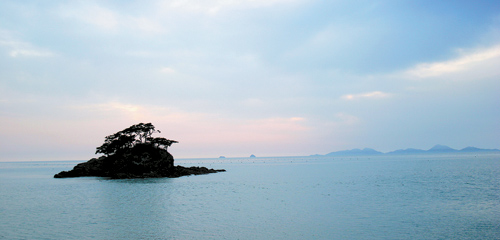
A beach at Byeonsanbando national park. By Park Soo-mee, JoongAng Ilbo
Song is one of many artists to draw inspiration from Seonun. A few kilometers away from the entrance there is a monument engraved with some verses by the famous poet Seo Jeong-ju. They depict the temple’s camellias as objects of longing.
Seonun Temple has all the refined beauty of a classic Korean temple. In spring the entire compound is covered in cherry blossoms and camellias. Perhaps it’s the name of the temple, which means “to practice zen meditation in the clouds,” that inspired so many literary minds.
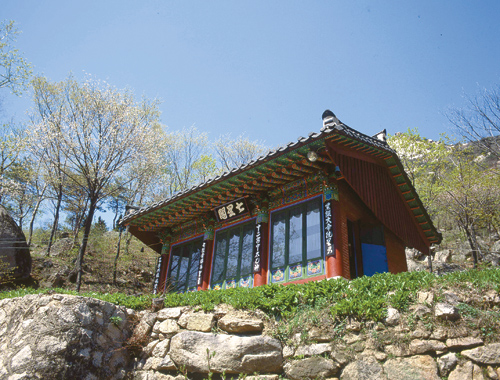
A sanctuary on a hill inside Seonun Temple. [JoongAng Ilbo]
Seonun Temple was built during the Baekjae Kingdom (18 B.C. to A.D. 678) around A.D. 577. Records show that the compound originally had 89 separate temples, 189 houses and 24 meditation cells with a population of 3,000 monks.
The buildings were partly damaged during the second Japanese invasion in 1597, but they are otherwise intact and the temple still serves as a Buddhist school, training new monks for the Jogye order, and as a sanctuary for some coveted relics including the Ma-ae Stone Buddha, said to be the largest stone carving of Buddha in Asia.
After a walk we visit the temple’s teashop, which offers an exquisite serving of jakseol, a local variety of green tea.
The Buddhist rituals involving tea are renowned for their formalism, being based on an old saying that “tea and Zen meditation are the same thing.” You get a taste of the tradition at the temple’s teashop.
The shop serves the tea on a tray with a small cup, a teapot, a strainer and a bowl. You pour hot water into the bowl, rinse it twice, and pour the water into the cup through a strainer. The rituals say that a cup of tea should be drunk in three sips, the first to observe the color, the second for the fragrance and the last for the taste.
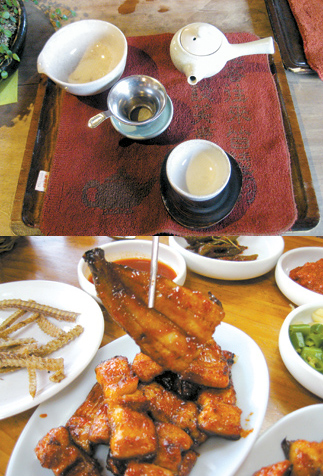
top, A serving of gree tea at a teashop inside Seonun Temple. below,marinated eels grilled on charcoal come with toasted eel bones, vegetables and soybean paste.
Epicures make trips to the town every spring to savor a piece of grilled eel, a food that’s said to give men extra virility. The father of Park Ji-sung, the Manchester United player, said before last year’s World Cup that his son built up his strength and stamina by eating a daily dose of grilled eel.
A plate of eel is usually accompanied by a bottle of bokbunja wine, a liquor made from wild mountain raspberries. The tasty combination, as well as the atmospheric scenery of the temple, attracts flocks of visitors, especially in the spring.
Eels in the region are caught after the wind blows them from the sea into a stream near the temple. Nowadays most eels sold in the county are cultivated in tanks by the restaurant owners, but the high level of salt in eels that are raised in the area’s unpolluted waters eliminates the muddy taste that is typical of the dish elsewhere.
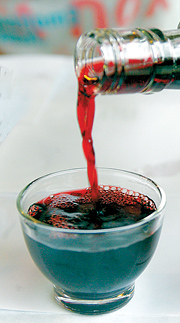
bokbunja, a wine made from wild mountain raspberries.
The are many ways to eat grilled eels. The most conventional approach is to wrap them in vegetables with a slice of garlic and a dab of soybean paste, the same way you would eat barbecued meat.
Bokbunja tastes like a sweet dessert wine at first, but it’s fairly easy to get drunk if you overlook the fact that it has a high alcohol content. On your way from the temple to downtown Gochang there is a field with a substantial number of stone dolmen. These large burial monuments were recently registered as a world heritage site, being precious artifacts from the Stone Age .
There are some 36,000 stone dolmens throughout the peninsula, the greatest number of dolmens in the world. Gochang is among the few places anywhere with a high density of dolmens. If you are a literary type try to drop into the Midangsi Museum of Literature, which has around 15,000 items connected to Seo Jeong-ju and his poetry. The great writer was born in the county.
In the late evening we move on to Gochang Fortress, which has one of the most spectacular illuminations I’ve seen in recent years. The construction of the fortress was meticulous. It was built during the Baekje period as a defense against enemy invasion. To the east, it’s surrounded by a mountain and three gates; there are two floodgates and a watch tower, plus a wall that stretches away from the main structure for 1,684 meters(more than 1 mile).
The place is perfect for a quiet stroll at night. From the wall inside the fortress the view sweeps across the entire county. There is a legend that says the sick can cure all their diseases if they walk once around the entire fortress with a stone on their heads ― and anyone who does three circuits will go to heaven.
The next morning we passed Byeonsanbando, a national park encompassing a beautiful estuary that flows into the Yellow Sea, heading toward Jeongup, a neighboring town famous for hanwoo, a type of Korean beef. There we had the most tender beef tenderloin for just 15,000 won per person. It was blissful. It’s hard to beat a trip where you can fill up with protein, cleanse your mind with a cup of tea, and book a place in heaven with a stroll around a castle wall.
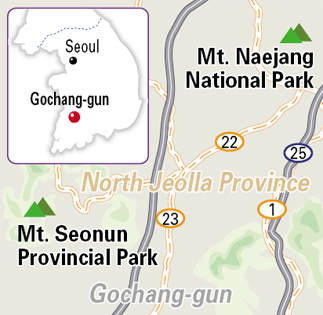
The most convenient way to get to Gochang is to take a bus from Gangnam Express Bus Terminal. It takes three-and-a-half hours, for 12,600 won. There are village buses from the bus terminal to the temple. There are clusters of eel restaurants near Seonun temple. The Yeongi Sikdang, a restaurant specializing in grilled eels, serves a set menu for 15,000 won. Seonunsan Tourist Hotel (063-561-3377) offers a clean ondol room for 90,000 won. The hotel has a seawater bath sauna, coffee shop and a restaurant. For cheaper options try Seonunsan Youth Hostel (063-561-3333), which is ideal for team workshops or student camps.
By Park Soo-mee Staff Writer [myfeast@joongang.co.kr]










with the Korea JoongAng Daily
To write comments, please log in to one of the accounts.
Standards Board Policy (0/250자)